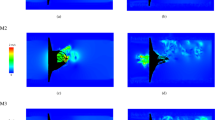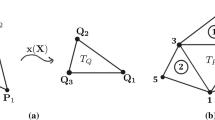Abstract
An incompressible transversely isotropic hyperelastic material for solid finite element analysis of a porcine mitral valve response is described. The material model implementation is checked in single element tests and compared with a membrane implementation in an out-of-plane loading test to study how the layered structures modify the stress response for a simple geometry. Three different collagen layer arrangements are used in finite element analysis of the mitral valve. When the leaflets are arranged in two layers with the collagen on the ventricular side, the stress in the fibre direction through the thickness in the central part of the anterior leaflet is homogenized and the peak stress is reduced. A simulation using membrane elements is also carried out for comparison with the solid finite element results. Compared to echocardiographic measurements, the finite element models bulge too much in the left atrium. This may be due to evidence of active muscle fibres in some parts of the anterior leaflet, whereas our constitutive modelling is based on passive material.
Similar content being viewed by others
References
Kunzelman KS, Cochran RP, Chuong C, Ring WS, Verrier ED, Eberhart RD (1993) Finite element analysis of the mitral valve. J Heart Valve Dis 2: 326–340
Einstein DR, Kunzelman KS, Reinhall P, Nicosia M, Cochran RP (2004) Haemodynamic determinants of the mitral valve closure sound: a finite element study. Med Biol Eng Comput 42: 832–846
Votta E, Maisano F, Soncini M, Redaelli A, Montevecchi FM, Alfieri O. (2002) 3-D computational analysis of the stress distribution on the leaflets after edge-to-edge repair of mitral regurgitation J. Heart Valve Dis 11: 810–822
Dal Pan F, Donzella G, Fucci C, Schreiber M (2005) Structural effects of an innovative surgical technique to repair heart valve defects. J Biomech 38: 2460–2471
Lim KH, Yeo JH, Duran CM (2005) Three-dimensional asymmetrical modeling of the mitral valve: a finite element study with dynamic boundaries. J Heart Valve Dis 14: 386–392
Prot V, Haaverstad R, Skallerud B (2007) Finite element analysis of the mitral apparatus: annulus shape effect and chordal force distribution. J Biomech Model Mechanobiol (Accepted, 2007)
Kunzelman KS, Cochran RP, Murphree SS, Ring WS, Verrier ED, Eberhart RC (1993) Differential collagen distribution in the mitral valve and its influence on biomechanical behavior. J Heart Valve Dis 2: 236–244
Grande-Allen KJ, Calabro A, Gupta V, Wight TN, Hascall VC, Vesely I (2004) Glycosaminoglycans and proteoglycans in normal mitral valve leaflets and chordae: association with regions of tensile and compressive loading. Glycobiology 14(7): 621–633
Jensen A, Baandrup U, Hasenkam J, Kundu T, Jørgensen C (2006) Distribution of the microelastic properties within the human anterior mitral leaflet. Ultrasound Med Biol 2(12): 1943–1948
Kuhl E, Holzapfel GA (2007) A continuum model for remodeling in living structures. J Mater Sci 42: 8811–8823
Prot V, Skallerud B, Holzapfel GA (2007) Effects of connective tissue pathologies on mitral valve response. MHM 2007, modelling of heterogeneous materials with applications in construction and biomedical engineering, Prague 2007, pp 106–107
May-Newman K, Yin FCP (1998) A constitutive law for mitral valve tissue. J Biomech Eng 120: 38–47
Weiss JA, Maker BN, Govindjee S (1996) Finite element implementation of incompressible, transversely isotropic hyperelasticity. Comput Meth Appl Mech Eng 135: 107–128
Rüter M, Stein E (2000) Analysis, finite element computation and error estimation in transversely isotropic nearly incompressible finite elasticity. Comput Meth Appl Mech Eng 190(5): 519–541
Holzapfel GA, Gasser TC, Ogden RW (2000) A new constitutive framework for arterial wall mechanics and a comparative study of material models. J Elast 61: 1–48
Prot V, Skallerud B, Holzapfel GA (2007) Transversely isotropic membrane shells with application to mitral valve mechanics. Constitutive modeling and finite element implementation. Int J Numer Meth Eng 71(8): 987–1008
Gruttmann F, Taylor RL (1992) Theory and finite element formulation of rubberlike membrane shells using principal stretches. Int J Numer Meth Eng 35: 1111–1126
Simo JC, Taylor RL, Pister KS (1985) Variational and projection methods for the volume constraint in finite deformation elasto-plasticity. Comput Meth Appl Mech Eng 51: 177–208
Holzapfel GA (2000) Nonlinear solid mechanics. A continuum approach for engineering. Wiley, Chichester
Flory PJ (1961) Thermodynamics relations for high elastic materials. Trans Faraday Soc 57: 829–838
Schröder J, Neff P (2003) Invariant formulation of hyperelastic transverse isotropy based on polyconvex free energy functions. Int J Solids Struct 40: 401–445
Balzani D, Neff P, Schröder J, Holzapfel GA (2006) A polyconvex framework for soft biological tissues. Adjustment to experimental data. Int J Solids Struct 43: 6052–6070
Humphrey JD (2002) Cardiovascular solid mechanics. Cells, tissues, and organs. Springer, New York, pp 139–140
Liao J, Vesely I (2003) A structural basis for the size-related mechanical properties of mitral valve chordae tendineae. J Biomech 36(8): 1125–33
Kunzelman KS, Cochran RP (1990) Mechanical properties of basal and marginal mitral valve chordae tendineae. ASAIO Trans 36: M405–408
Einstein DR, Kunzelman KS, Reinhall P, Nicosia M, Cochran RP (2005) The relationship of normal and abnormal microstructural proliferation to the mitral valve closure sound. J Biomech Eng 127(1): 134–147
Jimenez JH, Soerensen DD, He Z, He S, Yoganathan AP (2003) Effects of a saddle shaped annulus on mitral valve function and chordal force distribution: an in vitro study. Ann Biomed Eng 31: 1171–1181
Sonnenblick EH, Napolitano LM, Daggett WM, Cooper T (1967) An intrinsic neuromuscular basis for mitral valve motion in the dog. Circ Res 21: 9–15
Timek TA, Lai DT, Dagum P, Tibayan F, Daughters GT, Liang D, Berry GJ, Miller DC, Ingels NB (2003) Ablation of mitral annular and leaflet muscle: effects on annular and leaflet dynamics. Am J Physiol Heart Circ Physiol 285: 1668–1674
Curtis BC, Priola DV (1992) Mechanical properties of the canine mitral valve: effects of autonomic stimulation. Am J Physiol 31: 56–62
Belytschko T, Liu WK, Moran B (2000) Nonlinear finite elements for continua and structures. Wiley, Chichester, pp 231–232
Author information
Authors and Affiliations
Corresponding author
Rights and permissions
About this article
Cite this article
Prot, V., Skallerud, B. Nonlinear solid finite element analysis of mitral valves with heterogeneous leaflet layers. Comput Mech 43, 353–368 (2009). https://doi.org/10.1007/s00466-008-0310-2
Received:
Accepted:
Published:
Issue Date:
DOI: https://doi.org/10.1007/s00466-008-0310-2




